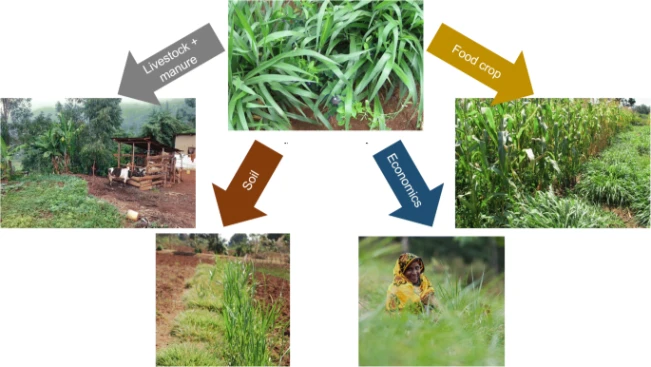Fodder crops, often overlooked heroes in agriculture, play a crucial role in feeding livestock and sustaining the agricultural ecosystem. These crops are specifically cultivated for animal consumption, providing essential nutrition for various livestock species.
Let’s delve into the world of these types of crops, exploring their types, cultivation practices, and the invaluable benefits they bring to farmers worldwide.
Role Of Fodder Crops In Agriculture
In the intricate tapestry of agriculture, fodder crops serve as the backbone of animal husbandry. Imagine a bustling farm where cows graze contentedly on lush green pastures or where chickens peck away at nutritious grains – these idyllic scenes owe much. Without these specialized crops, livestock farming would be a far more challenging endeavor.
It act as a reliable and sustainable source of nutrition for livestock, ensuring their health and productivity.
They provide essential nutrients such as carbohydrates, proteins, vitamins, and minerals, which are vital for the growth, development, and overall well-being of animals.
Whether it’s corn silage for dairy cows or alfalfa for horses, each fodder crop serves a unique purpose in meeting the dietary requirements of specific animal species.

Types of Fodder Crops
Fodder crops come in a diverse array, catering to the dietary needs of various livestock and prevailing environmental conditions. Among the most common types are:
| Types | Description |
|---|---|
| Grasses | Grasses like ryegrass, Bermuda grass, and fescue are popular fodder choices due to their high productivity and palatability. They are rich in carbohydrates and fiber, making them ideal for grazing or hay production. |
| Legumes | Leguminous crops such as alfalfa, clover, and soybean provide a valuable source of protein for livestock. These crops have nitrogen-fixing properties, enriching the soil and promoting sustainable agriculture practices. |
| Cereals | Cereal crops like corn, barley, and oats are not only staples in human diets but also serve as nutritious fodder for livestock. Whether harvested as silage or used as whole grains, cereals offer a rich source of energy and essential nutrients. |
| Forage Brassicas | Plants like turnips, kale, and rape are categorized as forage brassicas, prized for their rapid growth and high nutritional content. These versatile crops are often used as winter fodder or as part of a rotational grazing system. |
Growing And Harvesting Fodder Crops
The cultivation of fodder crops involves careful planning, proper management, and a deep understanding of agricultural practices. Farmers must consider factors such as soil fertility, climate conditions, and available resources when selecting and growing.
The process typically begins with land preparation, where soil is tilled, fertilized, and leveled to create an optimal growing environment. Seeds are then sown either directly into the soil or through methods like broadcasting or drilling, depending on the crop type and farming technique.
Throughout the growing season, farmers monitor the crops, implementing irrigation, weed control, and pest management strategies as needed. As the crops reach maturity, they are harvested using methods such as mowing, reaping, or grazing, ensuring maximum yield and nutritional quality.
Benefits Of Fodder Crops
The cultivation of these crops yields a myriad of benefits for farmers, livestock, and the environment alike. Some of the key advantages include:
Nutritional Support
They provide a balanced diet for livestock, promoting optimal growth, milk production, and reproductive performance.
Cost-Efficiency
By growing their own fodder, farmers can reduce reliance on expensive commercial feeds, thereby lowering production costs and improving profitability.
Soil Health
Certain fodder crops, particularly legumes, contribute to soil fertility through nitrogen fixation, reducing the need for synthetic fertilizers and enhancing long-term agricultural sustainability.
Crop Rotation
They can be integrated into crop rotation systems, helping break pest cycles, improve soil structure, and mitigate weed pressure.
Climate Resilience
Diverse fodder crop systems increase farm resilience to climate change by providing alternative forage options and mitigating risks associated with extreme weather events.
Happy Animals
When animals get their fill of fodder crops, they’re happier and healthier. And happy animals mean better produce for us humans.
Eco-Friendly Farming
By growing these types of crops, farmers are giving back to Mother Nature. These crops help maintain the ecological balance, making the planet smile.

Conclusion
Fodder crops might not be the talk of the town, but they’re the backbone of any farm. They ensure our animal friends are well-nourished, which in turn, nourishes us.
So the next time you see a field of green, tip your hat to the mighty crops – the unsung heroes of the agricultural world.
Read Also:
What Is O Farming: Make Money Online, Get Start & Benefits
Terrace Farming: Unlock The Potential Of Sustainable Agriculture
O Farming Investing: Online Platform, Higher Returns & Low Risks
Precision Farming: Revolutionizing Agriculture For A Sustainable Future
O Farming Investing: Online Platform, Higher Returns & Low Risks
Controlled Environment Agriculture: Cultivating The Future Of Farming

Meet Our Expert Agricultural Administrator
Welcome to agrigreenhands.com, your dedicated hub for all things related to agricultural farming. Leading the way in our commitment to sustainable and innovative practices is Jawad Hussain, our esteemed administrator with a profound background in agriculture….







